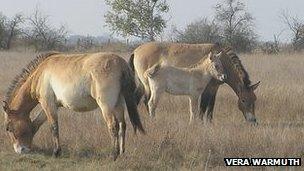Mystery of horse taming 'solved' by gene study
- Published

Przewalski’s horses are the closest wild relatives of the domestic horse
Horses were domesticated 6,000 years ago on the grasslands of Ukraine, southwest Russia and west Kazakhstan, a genetic study shows.
Domestic horses then spread across Europe and Asia, breeding with wild mares along the way, <link> <caption>research published in the journal PNAS</caption> <url href="http://www.pnas.org/content/early/2012/05/02/1111122109.abstract" platform="highweb"/> </link> suggests.
The work, by a Cambridge University team, brings together two competing theories on horse domestication.
The matter has been hotly contested by scientists.
Archaeological evidence suggests horses were tamed in the western part of the Eurasian Steppe (Ukraine, southwest Russia and west Kazakhstan).
Experts think they were used for riding, and as a source of meat and milk.
However, these archaeological clues - such as traces of horse milk found in ancient pots from the western Eurasian Steppe - are at odds with evidence from mitochondrial DNA.
These studies suggest domestication happened in many places across Europe and Asia.
The new study looked at nuclear DNA samples taken from 300 horses living in eight countries in Europe and Asia.
Genetic data was fed into computer models developed to look at different scenarios for domestication.
Dr Vera Warmuth from the Department of Zoology at Cambridge said: "It shows that horse domestication originated in the western part of the Steppes and that the spread of domestication involved lots of integration of wild horses."
The theory explains why evidence from mitochondrial DNA - which contains genes inherited solely from the mother - suggests horses were domesticated many times, in different places.
In fact, it appears that wild mares were used to re-stock herds of existing domesticated horses, perhaps because they did not breed easily in captivity.
This is the case with Przewalski's horse, which is the closest wild relative of modern horses.